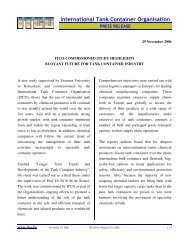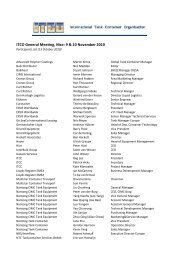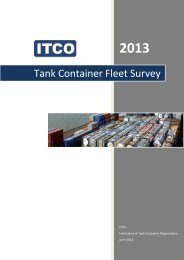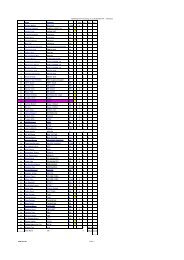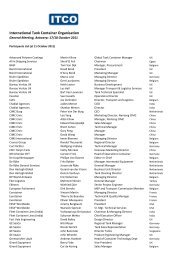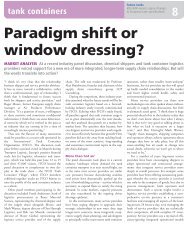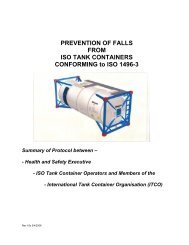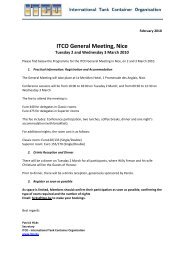Create successful ePaper yourself
Turn your PDF publications into a flip-book with our unique Google optimized e-Paper software.
ICHCA International <strong>Safe</strong>ty Panel Briefing Pamphlet No 30<br />
loading two cargoes into the end compartments where there are three<br />
compartments.<br />
10.3.4 If the tank container cannot be balanced, then the heavier end must be<br />
placed over the axles <strong>of</strong> a chassis / trailer when it is moved by road.<br />
10.3.5 In all cases, the Dangerous Goods Note or Non Regulated Goods Note (see<br />
Annex 4 Section 4.2) should clearly indicate the contents and mass <strong>of</strong> any<br />
cargo loaded into each <strong>of</strong> the compartments.<br />
10.4 Lifting and Carrying Appliances<br />
10.4.1 Generally, most items <strong>of</strong> lifting and carrying equipment used in ports can<br />
safely handle tank containers in the same way as other freight containers,<br />
i.e. by lifting from the top corner fittings via twistlocks in a lifting frame<br />
attached to a lifting appliance, and stacking corner fitting to corner fitting.<br />
10.4.2 However, the lifting, carrying and stacking activities should comply with the<br />
procedures specified after a general risk assessment has been undertaken.<br />
10.4.3 There is a general need for drivers to be aware <strong>of</strong> the special nature <strong>of</strong> tank<br />
containers, the free surface effect when making turns and when coming to<br />
abrupt stops. The possible issues are detailed in Annex 2 section A2.4 Free<br />
Surface Effect.<br />
10.4.4 The safe lifting, carrying and stacking <strong>of</strong> tank containers is <strong>of</strong> the utmost<br />
importance and is dependent on the appropriate risk assessment, the<br />
operational procedures in place and the skill, ability and attitude <strong>of</strong> the<br />
driver. In the unlikely event <strong>of</strong> hazardous substances leaking from the<br />
pressure vessel operators / drivers should immediately vacate the area and<br />
alert the appropriate emergency services.<br />
10.4.5 <strong>Tank</strong> containers are required by law to comply with the regulations<br />
pertaining to the product carried. The level <strong>of</strong> construction is strictly<br />
regulated and the risk <strong>of</strong> a leak <strong>of</strong> hazardous substances from a tank<br />
container is far less than that from a dry freight container containing drums<br />
or packages <strong>of</strong> hazardous material.<br />
10.4.6 When handling tank containers operators should be aware <strong>of</strong> the following<br />
exceptions:<br />
<strong>Tank</strong> containers are not fitted with fork lift pockets and lifting or<br />
transporting them using the tines <strong>of</strong> fork trucks is prohibited.<br />
End frame attachments should not be used to lift/carry tank containers<br />
ISO 3874 prohibits the use <strong>of</strong> side frames for all loaded tank<br />
containers.<br />
<strong>Tank</strong> containers may be lifted by slings but the lifting equipment<br />
should be <strong>of</strong> such design that there is a vertical force at the corner<br />
fittings, i.e. a chandelier spreader should be used.<br />
Angled slings may be used when attached to the bottom corner<br />
fittings only.<br />
Page 33 ©ICHCA International Limited



